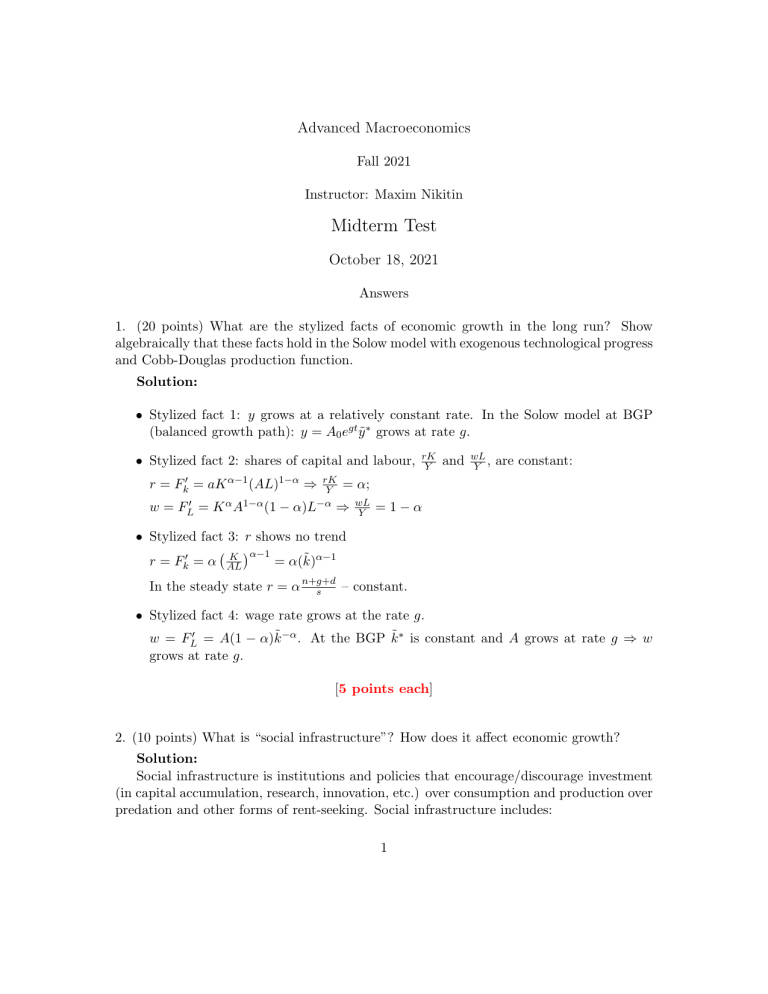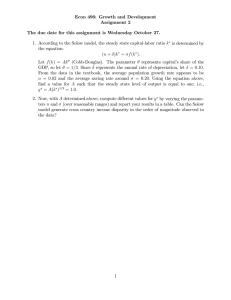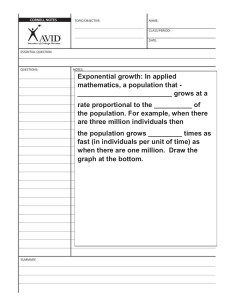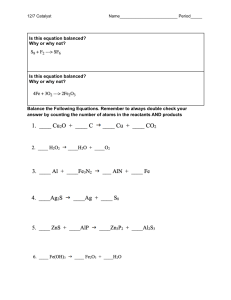
Advanced Macroeconomics Fall 2021 Instructor: Maxim Nikitin Midterm Test October 18, 2021 Answers 1. (20 points) What are the stylized facts of economic growth in the long run? Show algebraically that these facts hold in the Solow model with exogenous technological progress and Cobb-Douglas production function. Solution: • Stylized fact 1: y grows at a relatively constant rate. In the Solow model at BGP (balanced growth path): y = A0 egt ỹ ∗ grows at rate g. • Stylized fact 2: shares of capital and labour, rK Y and wL Y , are constant: r = Fk0 = aK α−1 (AL)1−α ⇒ w = FL0 = K α A1−α (1 − rK Y = α; −α α)L ⇒ wL Y =1−α • Stylized fact 3: r shows no trend K α−1 r = Fk0 = α AL = α(k̃)α−1 – constant. In the steady state r = α n+g+d s • Stylized fact 4: wage rate grows at the rate g. w = FL0 = A(1 − α)k̃ −α . At the BGP k̃ ∗ is constant and A grows at rate g ⇒ w grows at rate g. [5 points each] 2. (10 points) What is “social infrastructure”? How does it affect economic growth? Solution: Social infrastructure is institutions and policies that encourage/discourage investment (in capital accumulation, research, innovation, etc.) over consumption and production over predation and other forms of rent-seeking. Social infrastructure includes: 1 • Government fiscal policy. – Tax treatment of investment, capital gains, income and etc (how different parts of income are treated by the taxman). – Distortionary income tax versus consumption tax. • Monetary policy. High inflation is definitely bad for growth, because it is unstable, and makes the return on investment projects hard to predict. • Law enforcement, security, criminal justice. • Civil justice (particularly, contract enforcement). • Government as a rent-seeker (corruption, bribes, kickbacks, lobbyism). [7 points] Non-distortionary taxes, low inflation, contract enforcement, efficient court system, etc. are conducive to capital accumulation and innovation and higher rates of economic growth. [3 points] 3. (10 points) Does the CES production function h i1ρ Y = K ρ + (AL)ρ + (BE)ρ satisfy the constant-returns-to-scale property? Diminishing marginal returns? Suppose that A is the labour-augmenting technological progress, B is the energy-augmenting technological progress and ρ is a constant. Why would economists use this production function? Solution: CRS - yes. h h i1/ρ i1/ρ Y (tK, tL, t, E) = (tK)ρ + (tAL)ρ + (tBE)ρ = t K ρ + (AL)ρ + (BE)ρ [2 points] Diminishing marginal returns - yes, if ρ < 1. [1 point] 2 h i1/ρ Let [...] = K ρ + (AL)ρ + (BE)ρ . Then we have: 1 1 ∂Y 1 −1 −1 = ρK ρ−1 [...] ρ = K ρ−1 [...] ρ ∂K ρ 1 1 ∂2Y −1 −2 = (ρ − 1)K ρ−2 [...] ρ + K ρ−1 (1 − ρ)[...] ρ K ρ−1 = 2 ∂ K h i 1 = (ρ − 1)K ρ−2 [...] ρ −2 K ρ + (AL)ρ + (BE)ρ − K ρ < 0 [3 points] Economists use this prodcution function to account for changing shares of factors. [4 points, including 2 points for explicit derivation of a share] 4. (12 points). An economy described by the Solow model with exogenous technological progress (the model of chapter 2 of the Jones book) is in its steady state. At some moment of time the level of technology A rises instanteneously (for instsnce, because of a one-time major technological discovery). This is a one-time shock, the rate of technological progress is g after it, and the economy reaches the steady state. Show graphically how growth rate of output per worker and logarithm of aggregate consumption evolve over time. You have to draw graphs and explain them using words and formulas. Solution: A ↑⇒ k̃ ↓ below the steady state value. Hence, k̃ should rise towards its steady state value along transition path. [4 points] ˙ ẏ ỹ˙ k̃ = + g = α + g. y ỹ k̃ [2 points] 3 ẏ y g t T [2 points] Because of the jump in A, C increaes at T , then it grows faster than on the balanced grwoth path. lnC = ln(1 − s)Y = ln(1 − s) + αlnk̃ + lnA + lnL [2 points] ln C T t [2 points] 5. (48 points) Consider the following version of the “Learning-by-doing” endogenous growth model with constant aggregate labor force: the individual firm prodiction function is: 4 Y = K α [AL]1−α The investment share of output is s (an exogenous constant), and the knowledge accumulation occurs as a side effect of goods production: Ȧ = BY Suppose that population growth rate is n, and the depreciation rate is zero. B is an exogenous constant. A. (7 points) Interpret the assumption of “learning-by-doing”. Solution: The “learning-by-doing” assumption means that knowledge is accumulated as a side effect of a production process. B. (6 points) Compute expressions for gA and gK in terms of A, K and parameters of the model (for the aggregate economy). Solution: Ȧ = BK α [AL]1−α Ȧ = BK α A−α L1−α A K̇ = sY = sK α [AL]1−α gA = gK = K̇ = sK α−1 A1−α L1−α K C. (8 points) Sketch the phase lines ġA = 0 and ġK = 0 in (gA , gK ) space. Solution: g˙A = α(gK − gA ) + (1 − α)n gA g˙K = (α − 1)(gK − gA ) + (1 − α)n gK 5 g˙K = 0 gK gK = n + gA g˙A = 0 gA gK = − 1−α n + gA α D. (9 points) Using the graph analyze stability of the dynamic system. Under what additional assumptio(s) there exists a balanced growth parh? Solution: The system is unstable and has no balanced growth path unless n = 0. However, if n = 0, then we have: g˙K = 0 gK g˙A = 0 45o gA E. (10 points) Under the assumption(s) you outlined in D, compute growth rates of K, A and Y on the balanced growth path. Solution: On the balanced growth path gA = gK . 6 gA = B( K α 1−α K ) L = gK = s( )α−1 L1−α A A K s = A B s α 1−α gA = gK = B( ) L B gA = gK = B 1−α sα L1−α F. (8 points) Does a change in s affect the growth in the long-run? Discuss. Solution: Because of the learning-by-doing externality, the ‘knowledge production function Ȧ exhibits constant returns to scale in capital and knowledge, i.e. a proportional increase in both K and A has no negative impact on the growth rate of technology, Ȧ A . The mechanism is exactly the same as in the two-sector model of endogenous growth in the Romer textbook. 7




